Access to information has never been easier. Within seconds, search engines can present us with thousands of websites which all fit our request, most of which are free to access for the consumer. However, this content is certainly not free to produce.
Publishers are therefore on continuous lookout for ways to monetize their audience and, in particular, diversify their revenue streams given the ever falling advertising revenue potential and increasingly competitive digital subscription market.
One of the lesser known but incredibly valuable tools to overcome these challenges, as well as collect first-party data and increase audience engagement, is a registration wall.
What is a Registration Wall?
Just like all walls, registration walls create a value exchange between a publisher and their audience.
However, whilst a paywall (the most well-known wall-type) asks a user to pay for subscription in exchange for access to content, a registration wall requires users to create a free account in order to access content.
Also known as a regwall or regiwall, it turns anonymous visitors into logged-in users whose experience can be personalized and behavior analyzed across devices (desktop and mobile). There are therefore a huge number of benefits from employing a registration strategy, both for the publisher and their audience, such as providing a valuable solution to the challenge of the cookieless future.
What are the benefits of a registration wall?
- Support both advertising and subscription revenue streams
By de-anonymizing your users, you can gather data to present highly targeted advertising spots, ones that cost significantly more and are also more relevant for the reader.
Registration also plays a hugely valuable role in increasing a user's propensity to subscribe in the future, making it useful as a soft-conversion step to increase engagement prior to presenting your paywall and subscription offers. This helps you to find the perfect balance between frustration and engagement that's required for high conversion rates.
The graph below shows the conversion rate for different audience segments on one of our client's websites, proving the value in converting anonymous users into registered members prior to subscription.
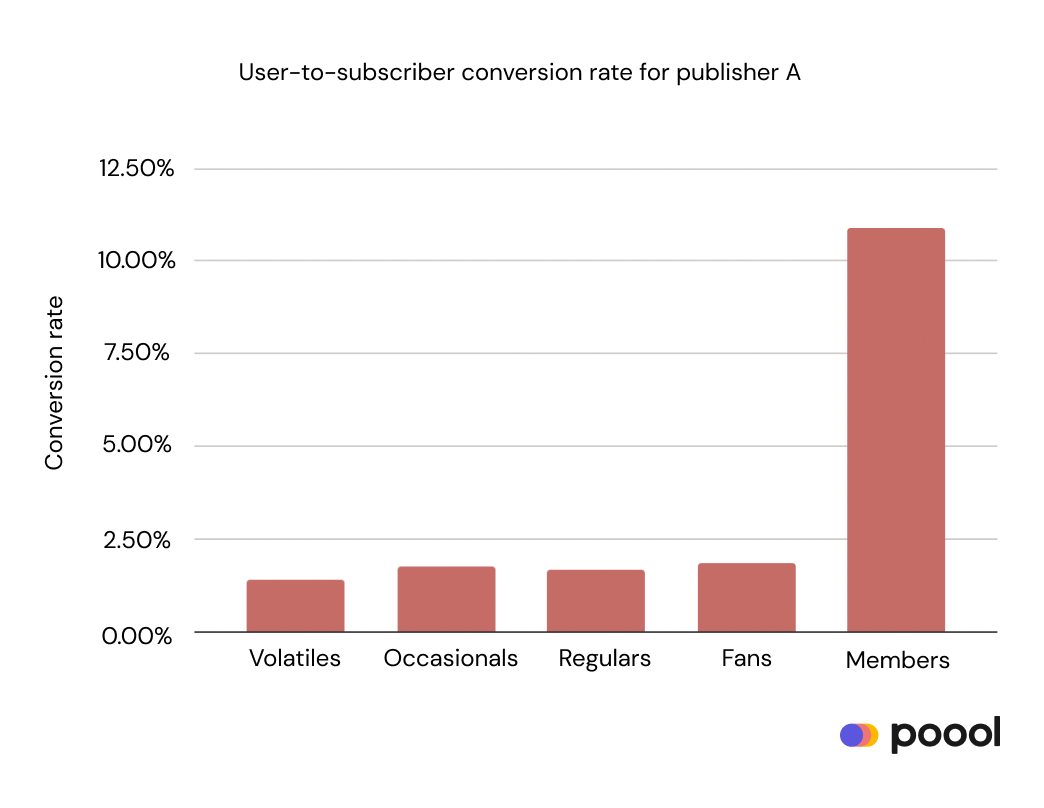
In fact, we've found that registered users are up to 200% more likely to convert to a subscriber than an unknown visitor.
- Collect first-party data
By requiring a reader to register before accessing content, you can track their interactions with your site and gain a better understanding of where they see value.
Not only can you do this through the registration form itself (i.e. collecting email address and other basic data points) creating a custom reader ID, but you can also progressively profile them as they consume content, gradually building a clear image of your reader.
What's more, there's external pressure to start collecting owned data due to Google and Apple's announcement of the cookieless future. A registration wall, however, provides a simple solution to turn this challenge into a valuable, monetizing opportunity.
- Create more personalized experiences
Knowing what a logged-in user consumes means you can make relevant suggestions, allow them to have a personalizable account space, configure notifications, etc. This is of course hugely beneficial for the reader but also for the publisher - a better user experience means higher engagement, more loyal audiences and closer relationships with your users.
Think of Netflix – it would take hours to search through all of the films and programs offered, but, luckily, they employ AI technology that learns from our viewing habits to present custom (and constantly updated) recommendations - simultaneously improving the user experience and increasing engagement to prevent churn.
- Added value provided to users when they create an account
As we've highlighted, a conversion wall (paywall, registration wall or other) only works by establishing a value exchange with users. By giving something to your audience, they'll be prepared to give you something back.
And whilst this is well-understood in a subscription strategy, it's often forgotten by publishers employing a registration model given that the wall is free to pass through. However, it's this 'added value' that you provide users who create an account that will encourage conversion as well as help to increase engagement.
What can you offer users in exchange for account creation?
- Exclusive content or even simply access to any content if employing a hard registration wall strategy
- UX features such as saving content for later, following topics or authors and configuring notification settings
- Ad-free experience
- The chance to support your business, particularly for publishers who are 'known' for free, independent journalism. The Guardian definitely falls under this category, informing users that registering helps the publisher without them having to pay a penny
Discover 12 ways to convert readers into members here:

My4, for instance, let's you go resume watching, save videos for later and access your viewing history.
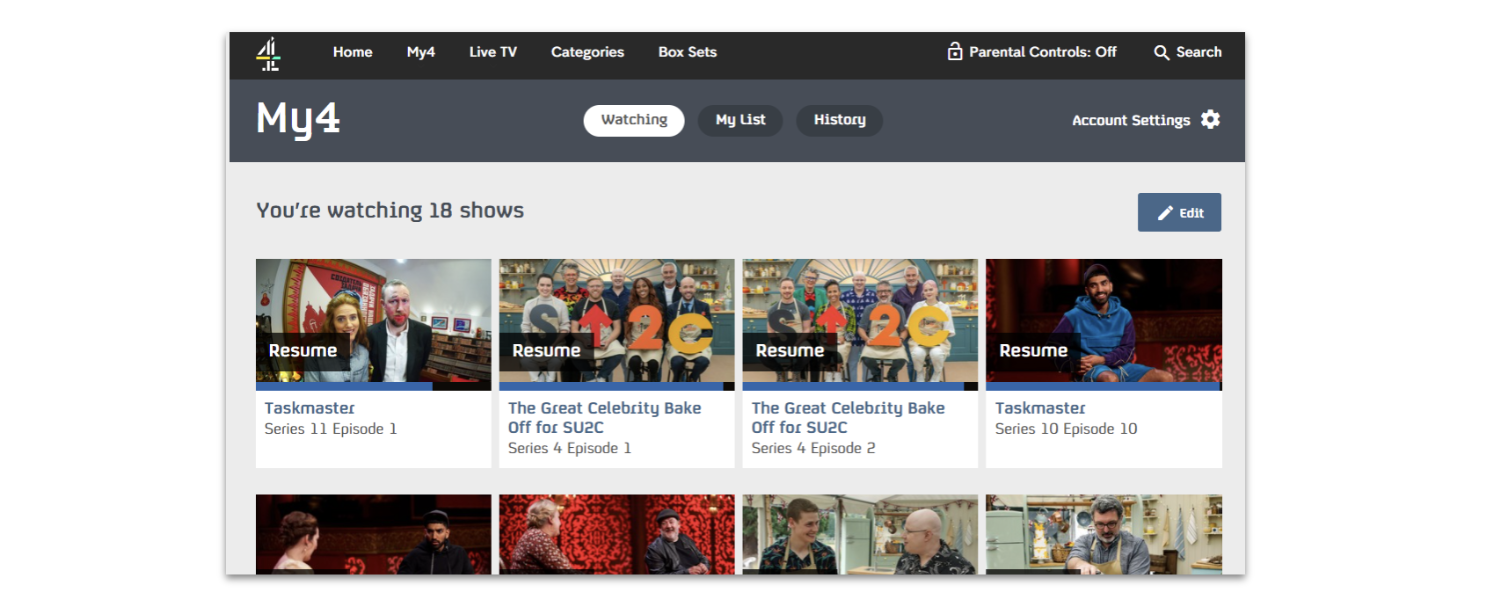
Note that registration walls are not just for news publishers but for any content-producer, including video & audio streaming websites, e-learning platforms, brands and social media sites.

Duolingo, a language learning website and app, requires visitors to register before accessing content. A user has the choice between accessing lessons for free or paying for Duolingo’s premium version which has various benefits (including an ad-free experience and access to premium content).
What does a Registration Wall look like?
A registration wall could appear as a publisher's landing page asking for account creation before accessing any content (like Pinterest) or be placed halfway through an article (like the NYT), allowing a reader to see the value proposition before being cut off by the wall.
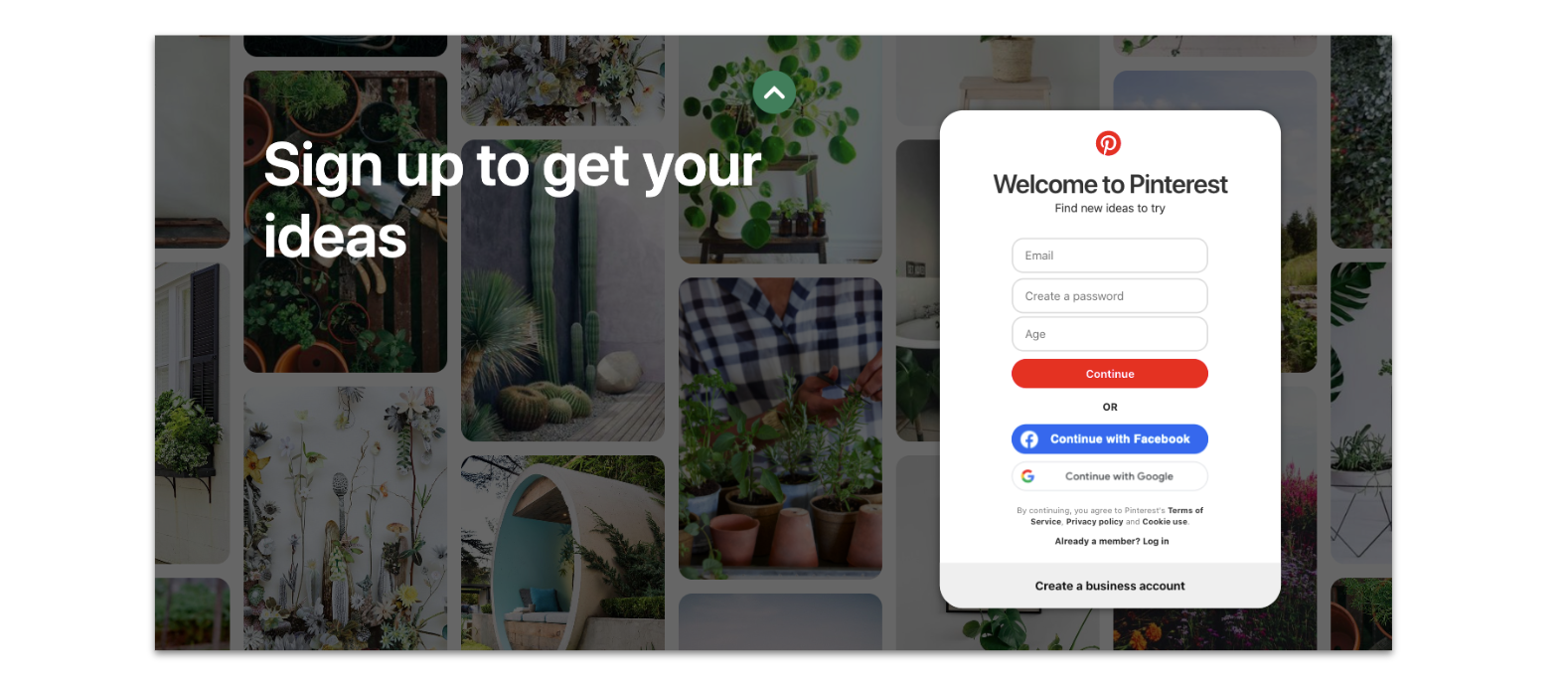
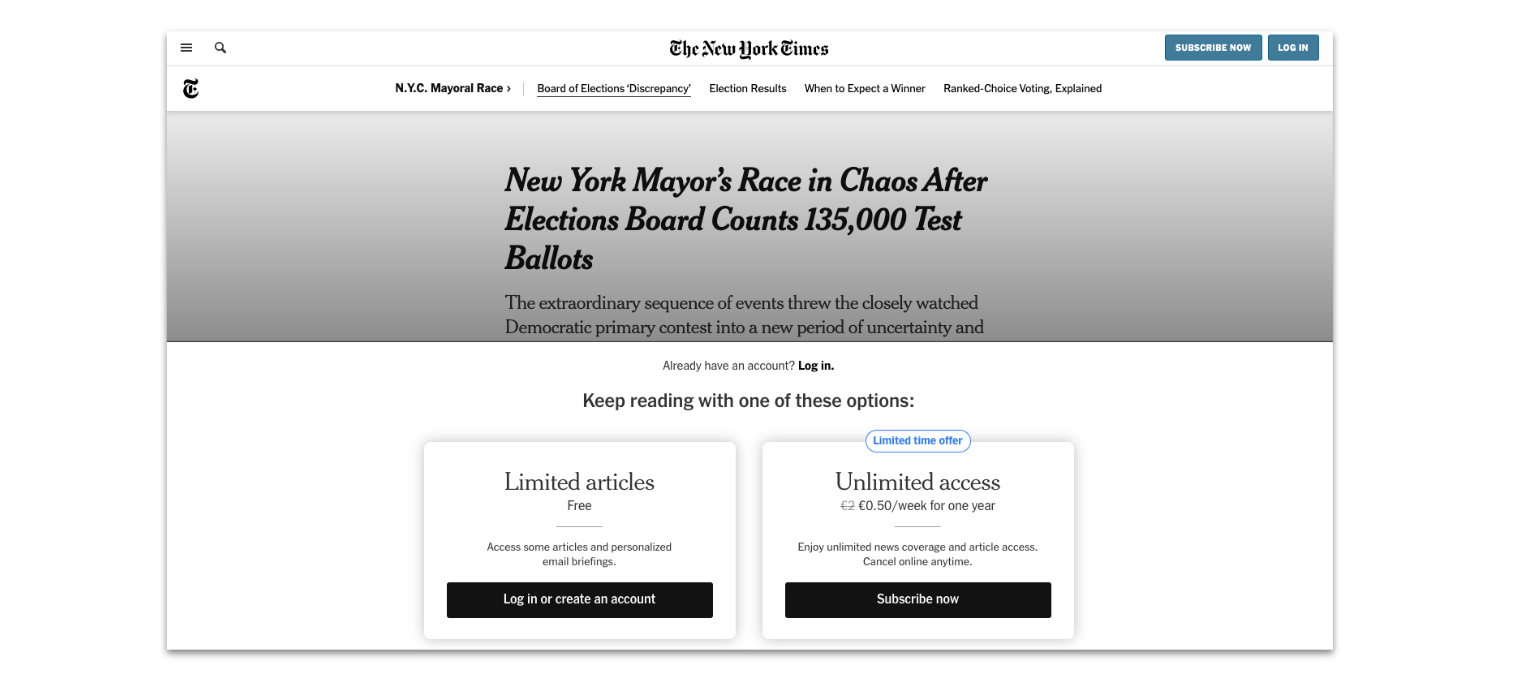
It usually consists of a form to fill in, often just asking for name and email address, although publishers sometimes require other data points. Most websites will also now give users the option to register using an existing social media account (e.g. Facebook, Apple or Google) making the process a lot simpler and allowing for data sharing.
However, as with anything, registration walls can differ hugely across content creator sites and there is no one-size-fits-all. Each publisher should choose their reg wall based on their own strategies and goals, carefully considering which wall will be most beneficial to them and their users.
Discover the best registration wall examples of 2022 in our article:

What are the different types of registration walls?
Just like any wall, there are 4 main registration wall models: freemium, metered, hard and dynamic.
Freemium models allow readers to access content with or without registering, giving them complete freedom to decide.
In 2020, The Guardian, a British publisher who is a famous advocate for free journalism, trialled a freemium registration wall to some of its readers. The message gives users the option to either register for free, sign-in or simply click ‘not now’ and continue reading, highlighting that their goal is not monetization (i.e. their registration wall isn’t the first step to subscription) but more that they want to build better relationships with their readers.
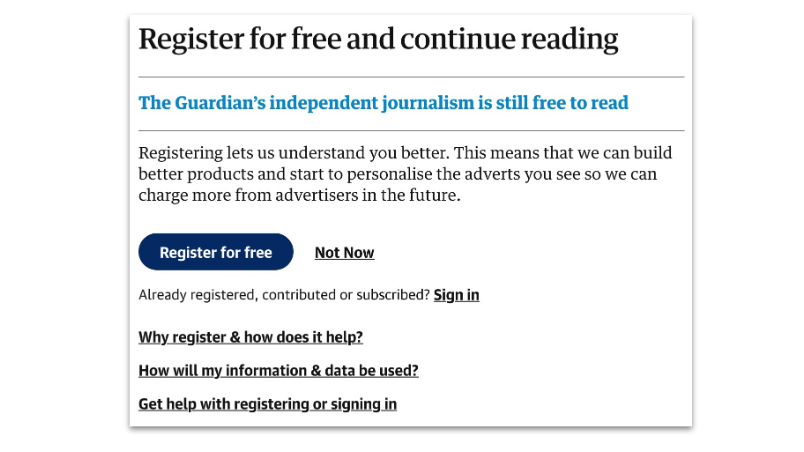
Alternatively, a metered model requires registration past a certain point, such as after reading 4 articles, after scrolling to a certain point on a page or time limited (e.g. days since last visit). This is the strategy employed by Harvard Business Review who informs users of how many articles they have left via a banner at the bottom of the screen. We're able to access 4 articles without an account, then 2 more once we register before being faced with a paywall.
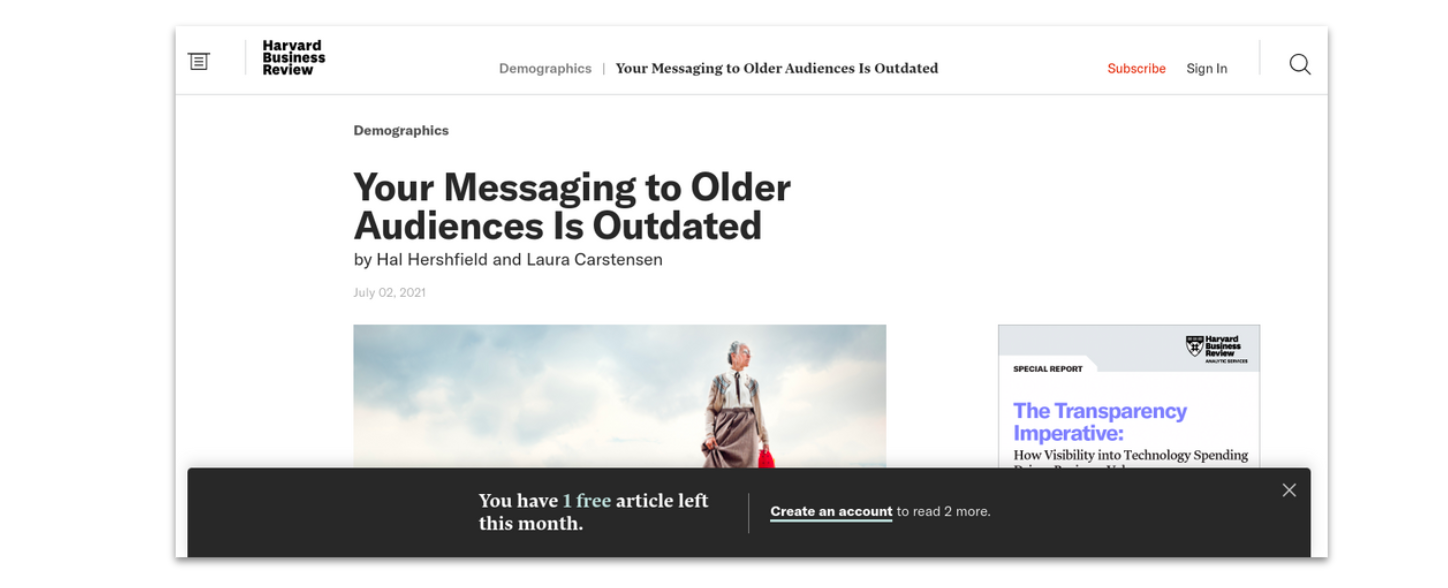
A publisher could instead employ a hard wall where registration is obligatory to access any content. This is often chosen by TV replay sites that offer their content for free but use the registration wall to track a user’s watching habits and provide them with a personalized experience. The British Channel 4, All4.com, employs this type of wall, offering users a free account (‘My4’) with access to their viewing history, recommended shows, and the ability to add programs to their ‘to-watch list’.
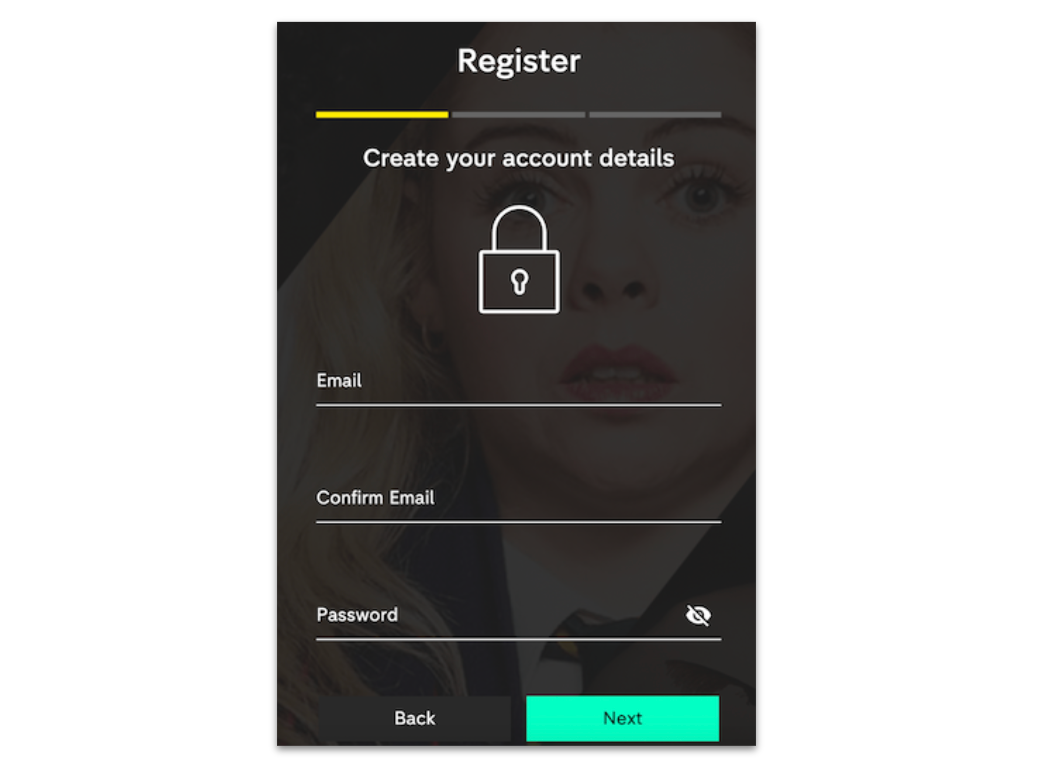
Finally, publishers could employ a dynamic registration wall which segments an audience based on criteria chosen by the publisher, giving each type of reader a different journey. For example, audiences could be segmented based on frequency of visits (fans vs regulars vs volatiles) or based on where they came from (Google vs Facebook).
A huge benefit of this dynamic approach is that it presents users with the most optimal wall journey for their profile. For example, more volatile visitors can be presented with a variety of soft conversion steps, gradually increasing their engagement with your content and leading them to a hard conversion (such as a hard reg wall or paywall). For fans and regular users, you can present them with a more direct and hard wall as these readers are far more likely to convert.
Poool's Audience Conversion Platform gives your marketing teams the autonomy to do exactly this! Our Dashboard has native and custom audience segmentation options, allowing you to design user journeys for each segment using our ready-made but fully customizable widget actions.
Interested in a registration wall for your site? Book a free demo and meeting with our team now to see how Poool's solution can help you achieve your goals!
Don't forget about SEO when integrating your registration into content!
Discover everything you need to know about walls and SEO in our dedicated white paper:

What’s the difference between a Paywall and a Registration Wall?
The word ‘wall’ in the online, content-producing context is used to refer to controlling access to content and asking for some form of value exchange. Both a paywall and registration wall achieve this, but the main difference is that a register wall doesn’t require a payment from the user, whereas a paywall does.
A paywall blocks access to content, requiring a reader to pay to subscribe before they can pass.

A registration wall also blocks access to content, but a reader will simply have to create a free account on the website before they can get past. The main 'value' that is being exchanged here is first-party data. Instead of paying for access, a user creates an account for free, meaning information about their profile, behavior, content preferences, etc. can be collected by the publisher.
Both types of wall have their advantages, for the content-producer and the reader, but they can be employed in different ways depending on the goals of the publisher. Notably, they could be used simultaneously, with registration being a soft conversion step to bring them closer to subscription. The creation of an account allows for more information to be gathered about the reader which can lead to insights, a more personalized user experience, increased loyalty, engagement and ultimately higher conversion rates.
With Poool you can integrate any type of wall into your user journeys, meaning that our solution is entirely flexible and adaptable to fit into any strategy. Whether you're seeking to increase engagement, conversion rates of users into account holders or subscribers, or simply collect first-party data, our solution will help you achieve your business goals.
Book a free demo and meeting with our team to discuss how we can help you or find out more about our products on our website!


